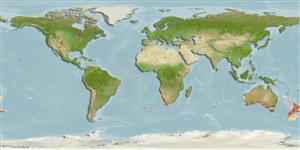| Native range | All suitable habitat | Point map | Year 2100 |

|
| This map was computer-generated and has not yet been reviewed. |
| Notopogon lilliei AquaMaps Data sources: GBIF OBIS |
Human uses
Phylogenetic diversity index
(Ref. 82805)
PD50 = 0.5315 many relatives (e.g. carps) 0.5 - 2.0 few relatives (e.g. lungfishes)
Trophic Level
(Ref. 69278)
3.5 ±0.5 se; Based on size and trophs of closest relatives
लौटाव
(Ref. 69278)
माध्यम, न्यूनतम जनसंख्या दुगनी होने का समय 1.4 - 4.4 वर्ष। (Preliminary K or Fecundity.)